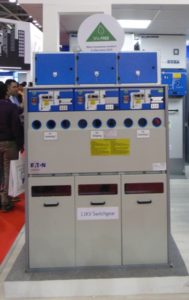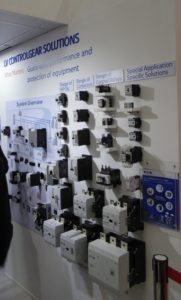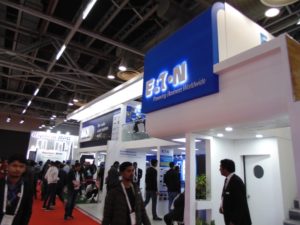 Eaton had on display SF6-free 11kV switchgear that is innovative in its design and was displayed at the forefront during ELECRAMA 2020. In this backdrop, T&D India caught up with Ripunjay Parikh, Director – Sales, Eaton Power Quality Pvt Ltd, to understand the dominant role of SF6, which unfortunately is not regarded as an environment-friendly gas, in switchgear and ring main units. Parikh discusses how Eaton, given its firm commitment to sustainability, is finding alternatives to minimize or even completely eliminate the use of SF6.
Eaton had on display SF6-free 11kV switchgear that is innovative in its design and was displayed at the forefront during ELECRAMA 2020. In this backdrop, T&D India caught up with Ripunjay Parikh, Director – Sales, Eaton Power Quality Pvt Ltd, to understand the dominant role of SF6, which unfortunately is not regarded as an environment-friendly gas, in switchgear and ring main units. Parikh discusses how Eaton, given its firm commitment to sustainability, is finding alternatives to minimize or even completely eliminate the use of SF6.
What have been recent innovations in Eaton’s switchgear portfolio?

With a vision to improve the quality of life and the environment, through the use of innovative power management technologies and services, Eaton is well committed to sustainability. We endeavor to make our factories and facilities zero-waste and zero-landfill. All our products are RoHs compliant. In terms of our products, we are building in a lot of innovation to reduce the impact on the environment. One such initiative is the solid insulated (SI) ring main unit.
Today, the options are limited. You have AIS that is very bulky and it also requires lot of maintenance. The other option is GIS that is compact but with an inherent risk of leakage of the greenhouse SF6 gas. However good your product is, mishandling of the unit can result in leakage, which can have deterrent impact. SF6 damages the ozone layer — a grave ecological threat. Also, SF6 leakage is going to temporarily put your system out of order. Handling SF6 is precarious.
Eaton has a unique product called solid insulated switchgear (SIS). This means that the entire current carrying part of the switchgear is insulated with an Eaton-patented insulating compound that ensures that you can reduce the overall size of the switchgear amazingly. Also, one can achieve the same high level of breaking capacities and safety standards as with SF6 insulated RMUs.
Besides being a sustainable product, it is also a virtually zero-breakdown device. We have installations for these units with a utility in western India part of the country where these devices are working for more than ten years without any problem or breakdown.
How does SIS compare in terms of cost?
This technology is relatively new and of course comes with an expense. However, if we consider that it is environment-friendly and virtually maintenance-free, the difference in cost is well justified. For critical installations that need 24×7 power, I would recommend SIS.
Eaton has the latest manufacturing facility with a fully robotic welding mechanism that ensures zero possibility of any defect.
How has been the response to SIS?
The western world has already made up its mind and is largely saying no to SF6. They are very keen to adopt SIS. We already have more than 100,000 installations across the globe of SIS devices. The 100,000th SIS unit was supplied late last year.
Coming to India, we have approached few progressive utilities with the SIS concept and they have really liked it. I feel that SIS could be a game changer for us in India too.
We hear of environmentally-safer alternatives to SF6.
Yes, Eaton is also actively working, and has made much headway, on an alternative gas, which is not as hazardous. We have already reached an advanced stage and we are waiting for the standardization agencies to come up with standards. However, we need to still look at the risk element of leaks. But yes, the hazard to environment will be less. The new technology will also be expensive because lot of effort goes into developing the alternatives and making sure that there are no risks. Over a period of time, these technologies will also become affordable. Till that time, a country like India has to strike a balance between value and benefit.
 On a technical point, could you elaborate on different roles of SF6 in GIS and RMU?
On a technical point, could you elaborate on different roles of SF6 in GIS and RMU?
Yes. SF6 can be used for two purposes. The first is as a switching medium in which you are actually operating the contacts. SF6 has an arc-quenching property by which it quickly quenches the electric arc. This makes the device compact. This, incidentally, today has migrated to vacuum interruption technology because it is more reliable, more compact and arcing happens in a very small enclosed medium. But normally, SF6 is more popular for higher voltages, say above 33kV, where the use of vacuum technology is not feasible.
In the lower ratings also, Eaton has circuit breakers in the 33kV range where we can achieve the same level of efficiency of a vacuum interrupter but by using SF6.
The second application of SF6 is using it as a pure insulating medium. In the RMU (ring main unit), we use SF6 to insulate all current-carrying parts inside a tank.
What are the typical causes of SF6 leakage?
Today, the manufacturing technology has advanced to a level where the leakages on account of a manufacturing defect are getting reduced. Eaton has the latest manufacturing facility with a fully robotic welding mechanism that ensures zero possibility of any defect. Secondly, we have the most advanced colour chromatography leak detection techniques where leakages can be detected, up to a level of even 0.1 PPM.
However, at the time of wiring, if you don’t do a proper termination of the cables, there will be stress on the bushings. The bushing is the most vulnerable part where leakage can occur. Secondly, improper handling during transportation or installation can aggravate the possibility of a leakage.
In Eaton’s hybrid circuit breaker technology, only the isolator is housed in an SF6 enclosure and that too using very negligible quantity of SF6.
Does Eaton also provide preventive maintenance?
Eaton devices are practically replacement-free. There is no need for replacement of SF6 because it is sealed for life. It is only in the event of accident that we will do maintenance. But as such, there is zero need for preventive maintenance.
What are some other interesting trends in switchgear technology?

One interesting trend coming up is the “hybrid switchgear”. We have conventional air-insulated switchgear (AIS) that is bulky. Then we have GIS with everything in a tank where lot of SF6 is being used.
In Eaton’s hybrid circuit breaker technology, only the isolator is housed in an SF6 enclosure and that too using very negligible quantity of SF6. Then you have a circuit breaker. The system is designed in such a way that you can reduce the geographical footprint by half. At the same time, we achieve the same level of performance without compromising on safety. We have demonstrated the technology in the HMH-36 series of hybrid switchgear primarily achieves the same level of performance, saves on space, saves on cost and restricts the use of SF6 to bare minimum.
We understand that industry and utility are your main customers. What is their relative share in Eaton’s electrical business?
In a very broad sense, RMUs is primarily driven by utilities while AIS/GIS is driven by industrial/commercial consumers.
Do you think government schemes have been contributing towards grid modernization?
Definitely! The initiatives driven by the Centre have been very well accepted by state governments and power utilities. Earlier, it was the APDRP scheme, then the IPDS. The reforms which we have seen in the metros and larger cities will be taken to tier-2 cities by which we are able to provide reliable and safe power supply. Power is one of the primary ingredients for driving growth. The moment you have reliable power, more industries will come, more consumers will come and the economy will also flourish.
(All photographs seen in this interview relate to Eaton’s booth at ELECRAMA 2020)


